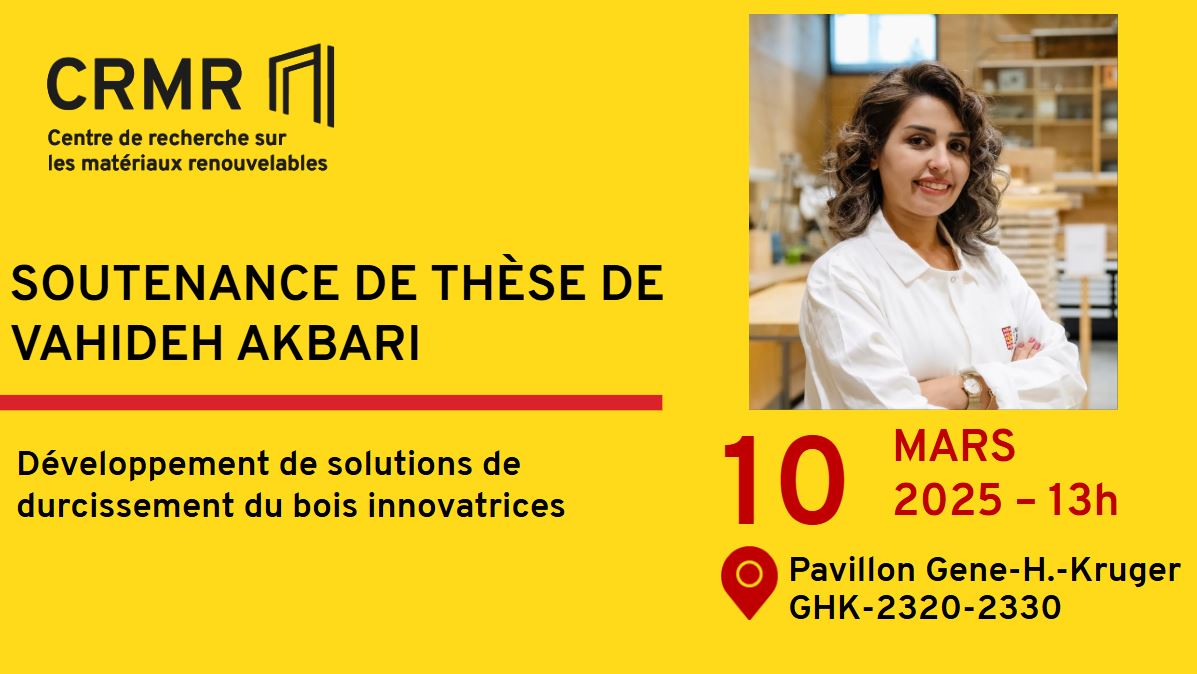Defense of Vahideh Akbari’s thesis – Doctorate in wood and bio-based materials engineering – Monday, March 10, 2025 at 1pm!
You are cordially invited to attend the thesis Vahideh Akbari‘s defense, a Ph.D. student in wood and bio-based materials engineering, which will take place on Monday, March 10, 2025, at 1 p.m., in the Gilbert-Tardif room (GHK-2320-2330) of the Gene-H.-Kruger Pavilion.
Connection link for those wishing to attend online:
https://ulaval.zoom.us/j/62709061766?pwd=r6OWVGWGNUq5LobEy9ogRK2GARbZbv.1
Jury Members:
- President: Marie-Hélène Vandersmissen – Faculty of Forestry, Geography, and Geomatics, Université Laval
- Research Supervisor: Véronic Landry – Faculty of Forestry, Geography, and Geomatics, Université Laval
- Co-supervisor: Stéphanie Sabrina Vanslambrouck – EMCO-Inortech ULC
- Internal Examiner: Pierre Blanchet – Faculty of Forestry, Geography, and Geomatics, Université Laval
- Internal Examiner: Jean-François Morin – Faculty of Science and Engineering, Université Laval
- External Examiner: Reza Foruzanmehr – Faculty of Engineering, University of Ottawa

Thesis Title: Development of Innovative Wood Hardening Solutions
Abstract : As an abundant and renewable resource, wood offers aesthetic appeal, resistance to deformation, and excellent durability when properly managed. However, its insufficient hardness limits its use in high-performance applications, particularly in appearance products (e.g., wooden flooring) for non-residential construction. This work proposes an innovative method to enhance wood hardness through chemical surface densification.
Wood densification, a technique aimed at reducing the volume of voids in wood, increases its density and consequently its hardness. In some cases, it also improves dimensional stability, lifespan, mechanical strength, and durability. This thesis seeks to develop a chemical surface densification approach with a focus on reducing the environmental impact of the process. We explored the chemical impregnation of different wood species using bio-based acrylate and malonate monomers. These monomers can undergo in-situ polymerization via the Michael addition reaction, which can be combined with ultraviolet (UV) photopolymerization to create a dual-cure system. The goal of this project is to enhance wood density and hardness while ensuring the sustainability of the densification process. The effectiveness of these methods was evaluated on three North American hardwood species: yellow birch (Betula alleghaniensis, Britt.), sugar maple (Acer saccharum, Marsh.), and red oak (Quercus rubra, L.). The selection of local species supports sustainability objectives by reducing time, energy, and environmental impact associated with transportation.
This thesis is structured around four main objectives. The first objective was to develop a formulation for wood densification that is easily polymerizable (requiring no external energy source and mild polymerization conditions) based on the Michael addition reaction, a green chemistry approach. The goal was to create an efficient formulation in terms of time, energy, operational processes, and environmental impact. The strategy included carrying out reactions at room temperature, using bio-based products with minimal solvents, and selecting local wood species. The formulations were then evaluated based on parameters such as polymerization kinetics, film hardness, formulation viscosity, and glass transition temperature.
The second objective was to examine the potential of the Michael addition reaction for surface densification of sugar maple. Five formulations from the first objective were selected, and a simple densification method was implemented under mild conditions based on previous studies. The properties of the densified wood prototypes were evaluated using X-ray densitometry and Brinell hardness tests. A statistical analysis (ANOVA) was performed on the results. Additionally, the morphology and penetration of the formulations into the wood lumens and cell walls were assessed using confocal Raman spectroscopy and scanning electron microscopy.
For the third objective, the most effective systems in terms of chemical retention, density profile, and hardness for sugar maple densification were applied to yellow birch and red oak to evaluate the effectiveness of these formulations on different wood anatomies (ring-porous and diffuse-porous species). The results were compared using the same analyses as for the second objective. The evolution of formulation viscosity during polymerization was also examined, and its correlation with the hardness and density of the densified wood was confirmed.
Finally, for the fourth objective, the potential of the dual-cure polymerization system to improve the properties of densified sugar maple wood was studied. This approach combines the advantages of two reactions—Michael addition followed by radical UV photopolymerization—to increase the crosslinking density of the formulation, further enhancing wood hardness.
The results demonstrate that the Michael addition reaction significantly increases wood hardness for all formulations, with even greater improvements when using dual-cure polymerization. The study also highlights the influence of formulation viscosity over time and polymerization kinetics on the effectiveness of wood densification. The approaches taken in this thesis not only improve the performance of wood for non-residential applications but also align with sustainable practices by using bio-based materials. The innovation of this research lies in its ability to balance improved wood properties with environmental sustainability, offering a promising solution to expand the use of wood in various construction applications.

